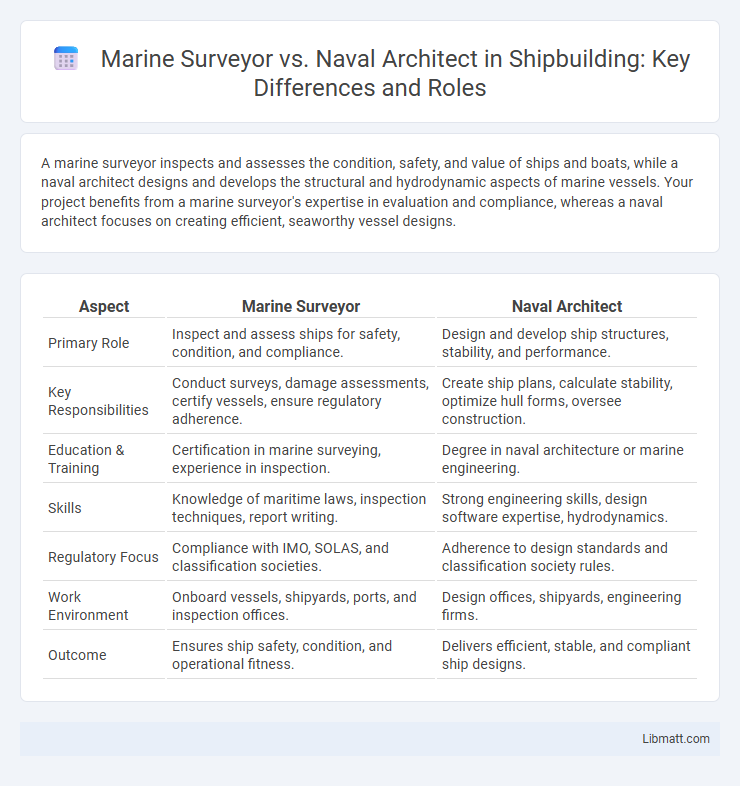A marine surveyor inspects and assesses the condition, safety, and value of ships and boats, while a naval architect designs and develops the structural and hydrodynamic aspects of marine vessels. Your project benefits from a marine surveyor's expertise in evaluation and compliance, whereas a naval architect focuses on creating efficient, seaworthy vessel designs.
Table of Comparison
| Aspect | Marine Surveyor | Naval Architect |
|---|---|---|
| Primary Role | Inspect and assess ships for safety, condition, and compliance. | Design and develop ship structures, stability, and performance. |
| Key Responsibilities | Conduct surveys, damage assessments, certify vessels, ensure regulatory adherence. | Create ship plans, calculate stability, optimize hull forms, oversee construction. |
| Education & Training | Certification in marine surveying, experience in inspection. | Degree in naval architecture or marine engineering. |
| Skills | Knowledge of maritime laws, inspection techniques, report writing. | Strong engineering skills, design software expertise, hydrodynamics. |
| Regulatory Focus | Compliance with IMO, SOLAS, and classification societies. | Adherence to design standards and classification society rules. |
| Work Environment | Onboard vessels, shipyards, ports, and inspection offices. | Design offices, shipyards, engineering firms. |
| Outcome | Ensures ship safety, condition, and operational fitness. | Delivers efficient, stable, and compliant ship designs. |
Introduction: Defining Marine Surveyors and Naval Architects
Marine surveyors inspect and assess the condition, safety, and compliance of vessels, ensuring seaworthiness and regulatory adherence. Naval architects specialize in the design, construction, and structural integrity of ships, focusing on hydrodynamics, stability, and performance. Your choice between these roles depends on whether you prefer hands-on inspection or creative vessel design.
Core Responsibilities of Marine Surveyors
Marine surveyors specialize in inspecting, surveying, and assessing the condition of ships, boats, and marine structures to ensure compliance with safety standards and regulations. They conduct detailed evaluations of hull integrity, machinery, cargo, and onboard equipment to detect defects, damages, or potential hazards. Their core responsibilities include certifying seaworthiness, investigating marine accidents, and providing expert reports for insurance claims and regulatory agencies.
Key Roles of Naval Architects
Naval architects specialize in the design, construction, and repair of ships, ensuring structural integrity, stability, and hydrodynamics through advanced engineering principles. They develop detailed plans and specifications for vessels, optimizing performance, safety, and compliance with maritime regulations. Their expertise is crucial in creating innovative ship designs that meet commercial, military, and environmental requirements.
Education and Training Requirements
Marine surveyors typically require a background in marine engineering, nautical science, or related fields, often supplemented with industry-specific certifications and on-the-job training in vessel inspection and maritime regulations. Naval architects usually hold a bachelor's degree in naval architecture or marine engineering, involving advanced coursework in ship design, structural analysis, and hydrodynamics, with many pursuing professional licensure or a master's degree for specialized expertise. Both careers demand practical experience; however, naval architects focus more on design principles and engineering theory, while marine surveyors emphasize inspection, compliance, and condition assessment.
Skills and Competencies Comparison
Marine surveyors possess expertise in vessel inspection, damage assessment, and regulatory compliance, emphasizing practical knowledge of maritime safety standards and survey techniques. Naval architects excel in ship design, structural analysis, and hydrodynamics, applying advanced engineering principles and computer-aided design (CAD) software to optimize vessel performance and stability. Both professions require a solid foundation in marine engineering, but marine surveyors focus on operational integrity while naval architects concentrate on innovative shipbuilding and design.
Work Environments and Typical Projects
Marine surveyors primarily work in ports, shipyards, and aboard vessels, conducting inspections to ensure compliance with safety standards and maritime regulations. Naval architects are typically based in design offices or engineering firms, focusing on the development and structural analysis of ships, offshore platforms, and submarines. Your choice between these careers depends on whether you prefer hands-on inspection roles or designing complex marine structures in a technical environment.
Certification and Professional Associations
Marine surveyors typically hold certifications such as the Certified Marine Auditor (CMA) or recognition from organizations like the Society of Accredited Marine Surveyors (SAMS). Naval architects often acquire credentials through institutions like the Royal Institution of Naval Architects (RINA) or the American Society of Naval Architects and Marine Engineers (SNAME). Both professions rely on these certifications and memberships to demonstrate expertise, adhere to industry standards, and ensure professional development.
Career Pathways and Opportunities
Marine surveyors typically follow a career pathway rooted in maritime inspection, specializing in vessel assessment, damage evaluation, and regulatory compliance, often gaining certification through maritime organizations. Naval architects pursue a more technical and engineering-focused trajectory, designing and developing ship structures and systems, usually requiring advanced degrees in naval architecture or marine engineering. Both careers offer diverse opportunities in shipbuilding, offshore industries, maritime safety, and consulting, with naval architects often engaged in design innovation and marine surveyors focused on regulatory oversight and condition assessment.
Salary and Job Outlook
Marine surveyors typically earn an average salary ranging from $50,000 to $90,000 annually, depending on experience and location, while naval architects command higher salaries, often between $70,000 and $120,000 per year due to their specialized engineering skills. Job outlook for marine surveyors is steady, driven by the need for vessel inspections and safety compliance in maritime industries, whereas naval architects face growing demand linked to advances in ship design, renewable marine energy, and military applications. Both professions offer strong career prospects, but naval architects generally experience faster employment growth and higher earning potential in the evolving marine engineering sector.
Marine Surveyor vs Naval Architect: Which Career to Choose?
Marine surveyors specialize in inspecting ships to ensure compliance with safety regulations and assess vessel conditions, focusing on maintenance and damage evaluation. Naval architects design and develop ship structures, systems, and performance, emphasizing engineering principles and innovation in marine vessel construction. Choosing between these careers depends on whether you prefer hands-on inspection and regulatory work or technical design and engineering creativity in the maritime industry.
Marine surveyor vs naval architect Infographic

 libmatt.com
libmatt.com